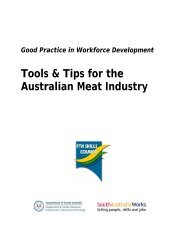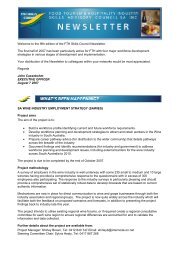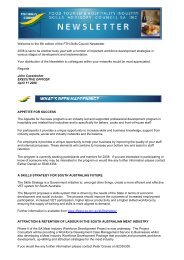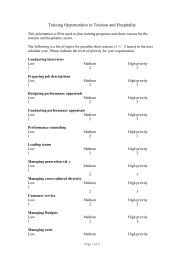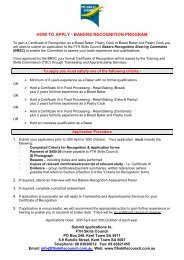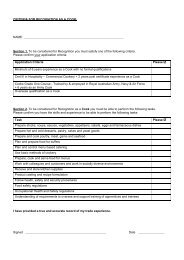SA Major Projects & Workforce Impacts - FTH Skills Council
SA Major Projects & Workforce Impacts - FTH Skills Council
SA Major Projects & Workforce Impacts - FTH Skills Council
You also want an ePaper? Increase the reach of your titles
YUMPU automatically turns print PDFs into web optimized ePapers that Google loves.
• Are the pay rates and working conditions competitive with<br />
other industries? How does my business and industry<br />
compare to my competitors and other industries for pay<br />
and conditions? Will major projects in my region have an<br />
impact? Will this impact be positive or negative?<br />
• How many of my employees are likely to retire in the next<br />
five years? What can I do to prevent potential retirees from<br />
leaving?<br />
• Have I considered what to do if key staff leave? Do I have<br />
a succession plan? Do I have the training in place in case I<br />
lose a key staff member? Am I willing to look at wider pool<br />
of labour such as mature aged, the underemployed (job<br />
sharing etc), indigenous and migrant groups?<br />
• Do I and the other managers have the skills and<br />
knowledge to be able to get the best of my staff? Do I<br />
provide enough leadership? Are the roles of my workers<br />
clear? Have we undertaken a skills and training audit of the<br />
current business requirements? Can we extrapolate this to<br />
the next five years and recruit and train for the likely gaps?<br />
• Do we understand the cultural and lifestyle expectations<br />
of our workers? Can we offer better work/life balance,<br />
flexibility, recognition, security, promotion opportunities and<br />
personal challenges within the constraints of the business?<br />
The Need for <strong>Workforce</strong><br />
Impact Assessments<br />
The graph below clearly indicates that South Australia faces<br />
the biggest workforce challenge in Australia. The “Forecast<br />
Reduction in Average Annual Employment Growth (% of<br />
baseline employment growth rate) due to population ageing,<br />
by State and Territory, 2004-05 to 2009-10” predicts that<br />
employment growth in <strong>SA</strong> will be restricted by 40% due to<br />
aging-related labour shortages and pressure.<br />
Forecast reduction in average annual employment growth<br />
(% of baseline employment growth rate) due to population ageing,<br />
by State and Territory, 2004-05 to 2009-10<br />
<strong>SA</strong><br />
ACT<br />
TAS<br />
VIC<br />
NSW<br />
AUS<br />
QLD<br />
WA<br />
NT<br />
17.4<br />
17.1<br />
20.3<br />
0 10 20 30 40 50<br />
This is why careful consideration of the workforce needs and<br />
impacts of a major project are more critical now than they<br />
have ever been before. Most major projects are required to<br />
carry out Environmental Impact Assessments, but only a<br />
small portion of major of projects are carrying out a detailed<br />
public or private workforce impact assessment. During the<br />
<strong>Workforce</strong> Impact <strong>SA</strong> project, when major project proponents<br />
were contacted, most of them did not know the likely<br />
direct employment outcomes of the project and had little<br />
understanding of the indirect impacts.<br />
24.7<br />
26.5<br />
27.4<br />
34.7<br />
36.1<br />
Percent of baseline employment growth rate<br />
Source: Centre of Policy Studies, MONASH model forecasts<br />
42.9<br />
A workforce impact assessment for each major project<br />
should be based on a consistent template that is demanddriven.<br />
This information will help build up a knowledge base<br />
to make indirect impact modeling more accurate in the future<br />
A suggested template would include:<br />
<strong>Major</strong> Project <strong>Workforce</strong> Impact Assessment Template<br />
Information provided by<br />
the project proponent<br />
Company Details<br />
– key company contacts<br />
Project Details<br />
Location, industry, $m value,<br />
planning, construction&<br />
operational timelines<br />
<strong>Workforce</strong> Requirements<br />
Direct company employment<br />
during each project phase<br />
Breakdown of qualification<br />
levels of employment<br />
Breakdown of employment<br />
duration<br />
Indirect Project <strong>Impacts</strong><br />
Project requirements for<br />
transport, accommodation,<br />
power,<br />
infrastructure, training,<br />
key resources & suppliers etc<br />
Competitive <strong>Impacts</strong><br />
Known positive or negative<br />
impacts on competitor or<br />
industry employment<br />
Government input &<br />
assistance that may apply<br />
Government<br />
contact officer(s)<br />
Project is added to the<br />
<strong>Major</strong> <strong>Projects</strong> Directory<br />
database<br />
Industry sector skills<br />
replacement analysis is<br />
undertaken<br />
Define what government<br />
assistance may be provided<br />
Provide links to relevant ISB,<br />
ESF network(s)<br />
Assess the need for/arrange<br />
impact modelling<br />
Link to relevant departments<br />
to clarify requirements and<br />
impact<br />
Provide general economic<br />
growth analysis<br />
<strong>SA</strong> <strong>Major</strong> <strong>Projects</strong> & <strong>Workforce</strong> <strong>Impacts</strong>



